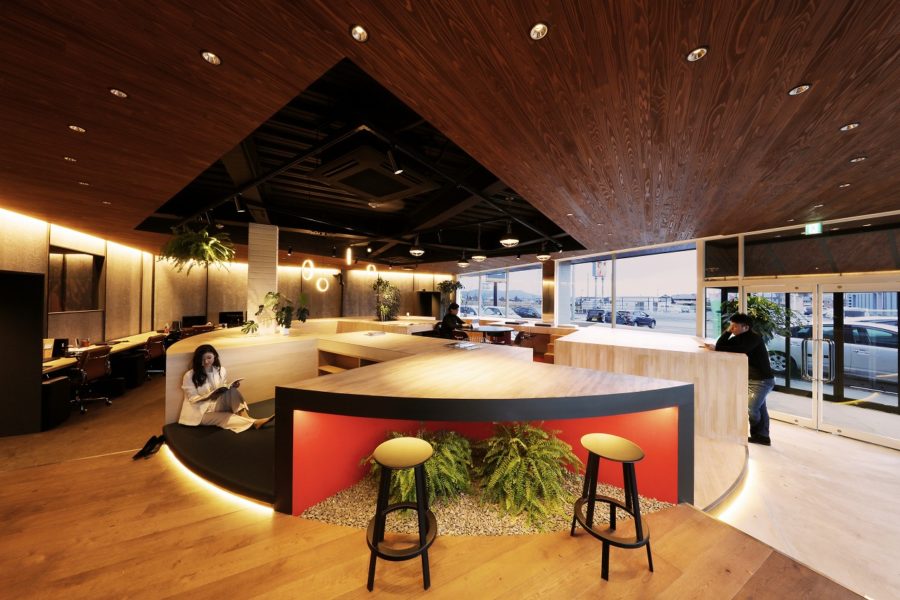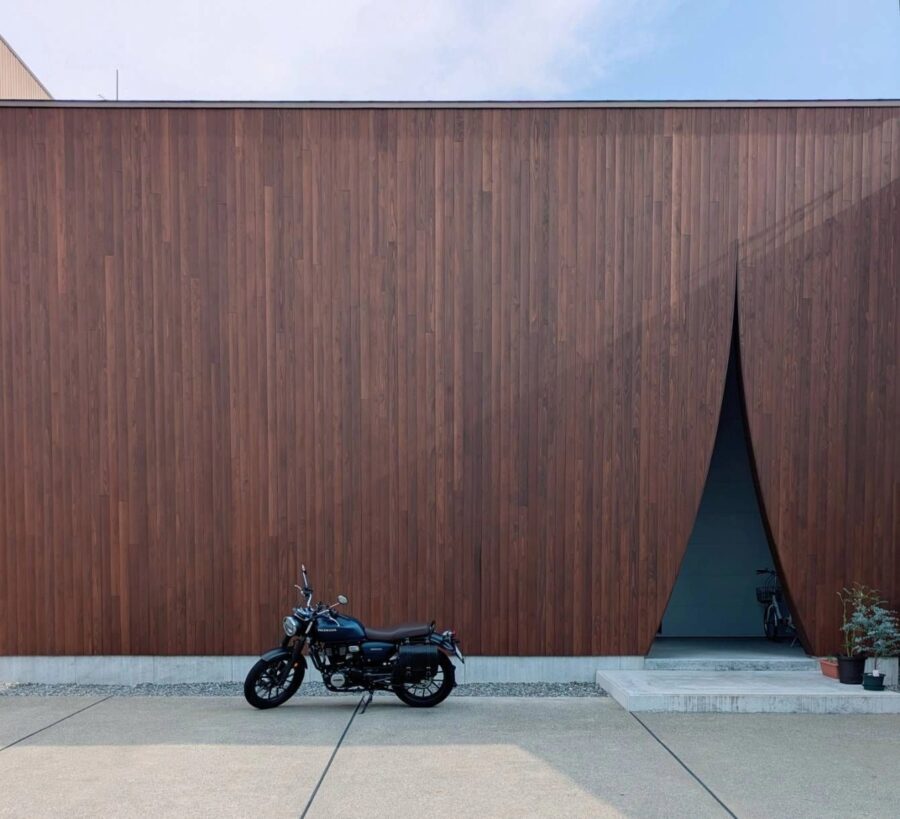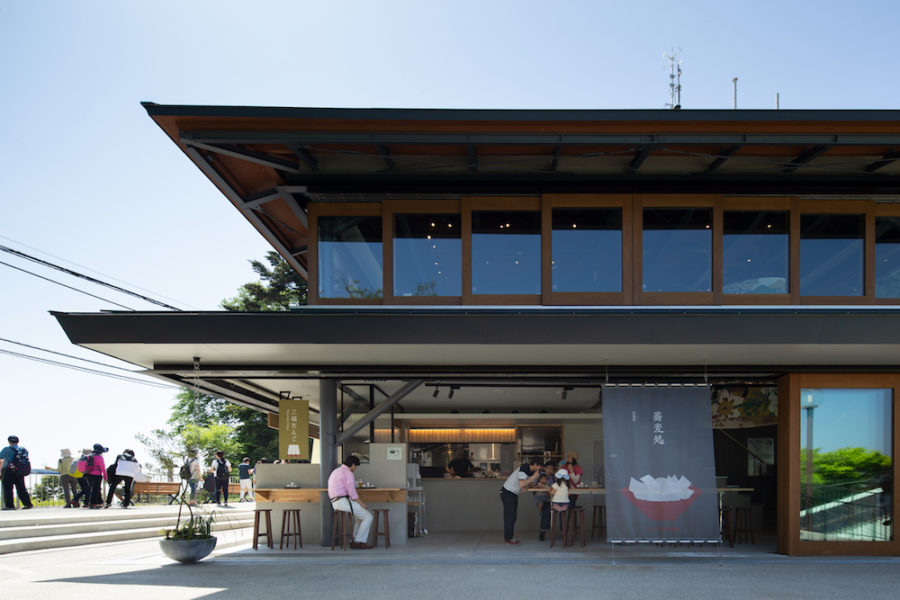中国上海で鮨屋の設計をすることになった。
設計をするにあたり、鮨職人が調理するように内装設計をできないかと考えた。
鮨職人のつくる1皿1皿には物語がある。食材の特徴、産地、季節を見極め、それらに合った最適の調理を行い、皿の上に美しく見立てる。このような鮨職人の一連の仕事は、日本文化の茶道や侘び寂びに通じるものがある。我々の設計手法も1つひとつの材料にこだわり空間と物語をつくり、設計における問題を茶道と侘び寂びの概念によって解決していくこととした。
敷地は茂名路沿いの老房子が建ち並ぶ小区を改築したエリアで、店舗の真裏には地下鉄南京西路駅が隣接するため人通りが激しい。
店舗内部は50m²と小さく、外部空間は幅約1.5m、長さが約20mという一見変わった敷地である。この敷地条件から日本の茶室が連想された。外部の喧騒を半屋外空間で消化し精神を整えながら小さな茶室に入っていくという動線計画によって茶道の体現を試みた。
本計画の主要材料は、スギとマツである。それらの木材を空間や場所を見極め、表面を焼き上げる。その際、焼き加減は、レア(20%)・ミディアム(50%)・ウェルダン(80%)のように3種類用意した。経年変化などを考慮し外部空間はスギを用い、内部空間はマツを用いた。
エントランス空間は、80%の黒光りした焼スギで覆われ、小さな庭のある日本風の半屋外露地である。のれんをくぐり細長い通路を通り、心を整えて店内に入っていくという茶道の精神を体現した。床材は敷石として花崗岩を配し、これは上海近郊の農村部で採れた廃材を利用することで侘び寂びの精神が現れる。
ガラスブロックで造られた蹲踞(つくばい)は、ブロックの短手を正面にもってくるように配置することで日光が乱反射し、その反射光が空間をより豊かにすることを狙いとした。壁面の土壁はこのエリアの老房子がフランス租界であったことからスペイン産の粘質土を用いた。フランスにおける土壁はスペイン産のものが使われることが多い。そういった歴史を参照し風土に根差すために、上海でもあえてスペイン産の粘質土を選定した。
奥に配されたベンチは、45cm角のスギを同じく丸焼きにしたものである。入口の扉は20%の焼き加減で焼かれたマツを用い、取手とフレームはコールテン鋼を用いた。
このように本計画に用いた材料は人工的な着色を極限まで排除し、材料自体の自然に現れる色彩をもって全体が構成されている。
入口の扉を開けて室内に入ると赤い土壁仕上げの天井がある。赤い天井は角をフィレットしながら徐々に天井高を下げていくデザインとした。低い扉を潜ることでお互いの立場を分け隔てなくする茶室からの参照である。徐々に低くなる通路を抜けると赤いカウンターが見える。この赤いカウンターは、日本最古の赤とされる漆塗りを用いた。その際、傷や劣化を抑えるため表面には車の塗装に使う保護材を使用した。天井は黒い和紙貼りとし、1枚の和紙が浮遊して見えるよう端部の見付けを極限にまで細くした。手作業でつくられたこの手揉み和紙は、黒い表現が豊かで繊細な表情をもつ日本・鳥取産の因州和紙を用いた。
カウンター奥の壁面は、鮨職人の仕事・ふるまいが美しく見えるよう、80%の焼き加減で焼かれたマツを用いた。カウンター内の土壁の角部分を黒竹で抑えることで、安全でありながら美しさと機能美を表現した。床材は墨入りコンクリートで土間のような表現とした。個室の扉は土壁とのバランスを考え20%の焼き加減で焼かれたマツを用いた。個室は扉を開けると、正面の開口部から中庭が見える。中庭に配された植物が漆塗のテーブルに反射し、空間全体が特別で華やかなものとなった。天井はカウンターと同様に因州和紙を用いた。壁面はスペイン産の土壁、床材はマツのフローリング敷きとした。
空間全体に行き渡る茶道と侘び寂びの精神と、1つひとつの空間や材料に対する職人的なこだわりのすべてがシンクロナイズし、小さな店舗でありながらも質のよい豊かな空間へとつくり上げることができた。(森下悠也+畑秀幸)
A sushi restaurant that spins a space and a story with ingredients like a chef cooks
This time we are fortunate to do the interior design of a sushi restaurant in Shanghai, China.
When designing, we wondered if it would be possible to create the interior like cooking sushi by sushi chefs.
There is a story in each dish created by sushi chefs. Every sushi chef needs to choose the most suitable cooking method according to the characteristics of the ingredients, the place of origins, and the season, and make it beautifully presented on the tableware. Such a sushi chef’s work is similar to the tea ceremony and Wabi-Sabi culture in Japan. In this design process, we also carefully selected each material, created a space with a story, and solved the design problems by the tea culture and Wabi-Sabi style.
The site is a renovated area along Maoming Road where old buildings are lined up, and since it is directly behind Nanjing West Road subway station, and the traffic is very heavy.
The inside of the restaurant is as tiny as 50 square meters, and the exterior space is seemingly unusual, with a width of about 1.5m and a length of about 20m. Such conditions remind us of Japanese tea room space. We used this exterior space to set up a semi-outdoor Roji (a Japanese term used for the garden through which one passes to the tea room for the tea ceremony) to isolate the noise from the outside world, allowing the guests to breathe in as if walking into a tea room. The traffic flow of this design faithfully restores the spirit of the tea ceremony.
The primary materials of this project are cypress and douglas fir. After we fully understand their characteristics and consider the attributes of the space used, we chose to fire the surface layer of the woods. In the whole project, three types of roasting were prepared, such as rare (20%), medium (50%), and well-done (80%). Cypress is used for outer space, and douglas fir was used for the inner space in consideration of aging.
The entrance space is a Japanese-style semi-outdoor roji with a small garden covered with 80% black yakisugi (roasted cypress). The guests lifted the Noren (the traditional Japanese fabric dividers). They stepped into the narrow corridor, abandoning the hustle and bustle in their hearts, full of the spirit of the traditional tea ceremony. Granite is used as paving stones for the floor material, and the spirit of Wabi-Sabi appears by using waste materials collected from the countryside in suburban Shanghai. We chose to make the washbasin (called “Tsukubai” in Japanese) with glass bricks. By placing the short sides of the glass bricks on the front, sunlight can be refracted into the inner space, and light and shadow are used to enrich the area. For the mud wall, we used Spanish clay, which is commonly used in French architecture. Since the site is located in an international shanghai settlement area, its architectural style is deeply influenced by France. To refer to such history and take root in the culture, we dared to select Spanish clay even in Shanghai. The benches on the inside of the roji also use roasted cypress, made of a whole cypress pile with a section of 45x45cm. The door leading to the interior is made of 20% light-roasted douglas fir, and the handle and door frame is made of corten steel plate. In this way, the material used in this project eliminates artificial coloring to the utmost limit and is composed entirely of the naturally appearing colors of the materials themselves.
When you open the entrance door and enter the room, you will find a ceiling with a red clay wall finish. The red top is chamfered to form a shape from high to low gradually. Due to the low entrance opening, everyone has to bow and enter. We will let visitors experience the spirit of the tea ceremony without distinction. After passing through the gradually lower corridor, the bright red bar is very eye-catching. The lacquered red used in the red bar counter is also known as the earliest red in Japan. To reduce the impact of scratches and deterioration over the years, we added a protective coating that is often used on the surface of the car body on the countertop. Black washi paper was pasted on the ceiling, and the edge was made as thin as possible so that the piece of washi paper could be seen floating in the air. The black washi is hand-processed to form a wrinkled effect, and the texture is vivid and delicate. The raw material is Inshu washi, produced in Tottori, Japan. To reflect the cooking process and figure of the sushi chef, we use 80% deep-roasted douglas fir as the back wall behind the bar. The outside corners of the clay wall on the inner side of the bar are wrapped in black bamboo to ensure safety while showing functional beauty. The floor material is blackened concrete, which is expressed like a rough floor. When choosing the private room door material, considering the matching degree with the clay wall, we decided on 20% light-roasted douglas fir. After opening the door of the secret room, you can see the courtyard from the front opening. The plants planted in the yard are reflected on the red lacquered countertops, making the whole space gorgeous. As for the ceiling, Inshu washi was used as well as the counter. The walls are made of clay made in Spain, and the floors are made of douglas fir.
The spirit of the tea ceremony and Wabi-Sabi permeate the entire space, and the sushi chef’s commitment to each thing is all synchronized in the interior design. We can create a high-quality and rich space even though it is a compact restaurant. (Yuya Morishita + Hideyuki Hata)
【Kurenai Restaurant】
所在地:上海市茂名北路281弄16号
用途:レストラン・食堂
クライアント:GOLDEN TWISTERS
竣工:2020年
設計:YUHI STUDIO
担当:森下悠也、畑秀幸、袁慧瑜
サイン:七月合作社
照明設計:コイズミ照明
施工:上海云豹装饰设计装饰有限公司
撮影:YUHI STUDIO
工事種別:コンバージョン
構造:RC造
規模:地上1階
延床面積:78.00m²
設計期間:2020.05-2020.06
施工期間:2020.07-2020.09
【Kurenai Restaurant】
Location: No.16, Lane281, Maoming North Road, Shanghai, China
Principal use: Restaurant
Client: GOLDEN TWISTERS
Completion: 2020
Architects: YUHI STUDIO
Design team: Yuya Morishita, Hideyuki Hata, Yuan Huiyu
Sign design: July Cooperative Company
Lighting design: KOIZUMI Lighting
Contractor: Shanghai Yunbao Indoor Design & Decoration
Photographs: YUHI STUDIO
Construction type: Conversion
Main structure: Reinforced Concrete construction
Building scale: 1 story
Total floor area: 78.00㎡
Design term: 2020.05-2020.06
Construction term: 2020.07-2020.09








